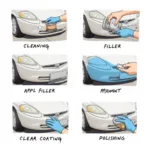Fiberglass car body repair is a common procedure for fixing damage ranging from minor cracks to significant holes. Understanding the process, materials, and techniques involved is crucial for both car owners and professionals in the automotive industry. This guide delves into the intricacies of fiberglass car body repair, offering valuable insights for achieving professional-quality results.
Repairing fiberglass car bodies requires specific tools and materials, including fiberglass resin, hardener, fiberglass matting, sandpaper, body filler, and a sanding block. Choosing the correct materials ensures a durable and long-lasting repair. Shortly after the introduction of fiberglass car bodies, it became apparent that they offered unique advantages over traditional metal bodies. They were lighter, resistant to rust, and could be molded into complex shapes. This is why knowing how to repair them properly is such a valuable skill. Learn more about fixing rust damage in our article on car body repair kit rust.
Understanding Fiberglass Repair
Fiberglass, a composite material made of glass fibers embedded in a resin matrix, is widely used in car body construction due to its lightweight and durable properties. However, it is susceptible to damage from impacts, stress, and weathering. Understanding the nature of the damage is the first step towards a successful repair.
Assessing the Damage
Before starting any fiberglass car body repair, assess the extent of the damage. Minor cracks can often be repaired with resin and filler, while larger holes or deep gouges may require fiberglass matting and patching. Identify any underlying structural damage that may need attention before proceeding with the cosmetic repair.
What are the common types of fiberglass damage?
Common types include cracks, chips, holes, and delamination. Each type requires a slightly different repair approach.
Step-by-Step Fiberglass Car Body Repair Guide
A successful fiberglass car body repair involves a systematic approach. The following steps outline the general process, adaptable based on the specific damage.
-
Preparation: Clean the damaged area thoroughly, removing any loose debris, dirt, or grease. Sand the area around the damage to create a rough surface for better adhesion. For protection, check out tips on preventing eye irritation from dust in our article on car body repair inhaling dust eyes.
-
Mixing the Resin: Mix the fiberglass resin and hardener according to the manufacturer’s instructions. The ratio is crucial for proper curing.
-
Applying the Resin: Apply the resin to the damaged area, ensuring it penetrates the cracks or fills the hole. If using fiberglass matting, apply a layer of resin, then lay the matting over it, and saturate it with more resin.
-
Layering and Shaping: For larger repairs, apply multiple layers of fiberglass matting and resin, allowing each layer to cure slightly before applying the next. Shape the repair as needed using a sanding block.
-
Sanding and Finishing: Once the resin has fully cured, sand the repaired area smooth, blending it with the surrounding surface. Apply body filler if necessary to achieve a seamless finish.
How long does it take for fiberglass resin to cure?
The curing time varies depending on the type of resin and the ambient temperature, but it typically takes a few hours.
Tips for a Professional Finish
Achieving a professional-looking fiberglass car body repair requires attention to detail and some helpful tips. Consider using a gelcoat for a smooth, glossy finish. Ensure proper ventilation during the repair process, as the fumes from the resin can be harmful. Practice on scrap fiberglass before attempting repairs on your car. If you are dealing with a hole in your car’s body, you might find our article on car body hole repair useful. For smaller repairs, a car body fibreglass repair kit could be sufficient.
John Smith, a renowned auto body repair expert, emphasizes the importance of proper surface preparation. “A clean and properly sanded surface is crucial for achieving a strong and lasting fiberglass repair,” he says. “Neglecting this step can lead to adhesion problems and premature failure of the repair.”
Conclusion
Fiberglass car body repair requires patience and attention to detail. By following the steps outlined in this guide and utilizing the appropriate materials, you can achieve professional-quality results. Remember to always prioritize safety and proper ventilation during the repair process. Car body repair fiberglass offers a cost-effective solution to restoring your vehicle’s appearance and structural integrity. Explore more about specialized car body repairs in our piece on a j services car body repairs coventry 1980.
FAQ
- Can I repair fiberglass myself?
- What type of resin should I use for car body repair?
- How do I prevent air bubbles in the resin?
- What is the best way to sand cured fiberglass?
- How long does a fiberglass repair typically last?
- How much does it cost to repair a fiberglass car body?
- What are the common mistakes to avoid during fiberglass repair?
Need further assistance? Contact us via WhatsApp: +1(641)206-8880, or Email: [email protected]. Our 24/7 customer service team is always ready to help.

